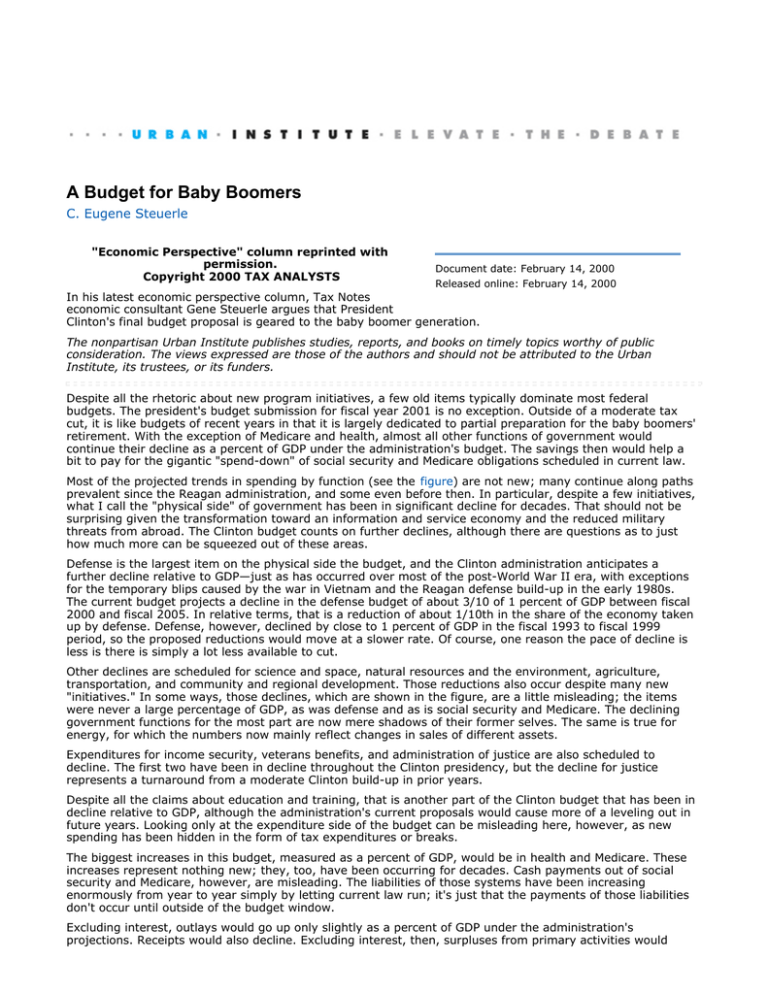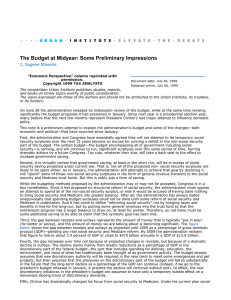A Budget for Baby Boomers C. Eugene Steuerle
advertisement

A Budget for Baby Boomers C. Eugene Steuerle "Economic Perspective" column reprinted with permission. Copyright 2000 TAX ANALYSTS Document date: February 14, 2000 Released online: February 14, 2000 In his latest economic perspective column, Tax Notes economic consultant Gene Steuerle argues that President Clinton's final budget proposal is geared to the baby boomer generation. The nonpartisan Urban Institute publishes studies, reports, and books on timely topics worthy of public consideration. The views expressed are those of the authors and should not be attributed to the Urban Institute, its trustees, or its funders. Despite all the rhetoric about new program initiatives, a few old items typically dominate most federal budgets. The president's budget submission for fiscal year 2001 is no exception. Outside of a moderate tax cut, it is like budgets of recent years in that it is largely dedicated to partial preparation for the baby boomers' retirement. With the exception of Medicare and health, almost all other functions of government would continue their decline as a percent of GDP under the administration's budget. The savings then would help a bit to pay for the gigantic "spend-down" of social security and Medicare obligations scheduled in current law. Most of the projected trends in spending by function (see the figure) are not new; many continue along paths prevalent since the Reagan administration, and some even before then. In particular, despite a few initiatives, what I call the "physical side" of government has been in significant decline for decades. That should not be surprising given the transformation toward an information and service economy and the reduced military threats from abroad. The Clinton budget counts on further declines, although there are questions as to just how much more can be squeezed out of these areas. Defense is the largest item on the physical side the budget, and the Clinton administration anticipates a further decline relative to GDP—just as has occurred over most of the post-World War II era, with exceptions for the temporary blips caused by the war in Vietnam and the Reagan defense build-up in the early 1980s. The current budget projects a decline in the defense budget of about 3/10 of 1 percent of GDP between fiscal 2000 and fiscal 2005. In relative terms, that is a reduction of about 1/10th in the share of the economy taken up by defense. Defense, however, declined by close to 1 percent of GDP in the fiscal 1993 to fiscal 1999 period, so the proposed reductions would move at a slower rate. Of course, one reason the pace of decline is less is there is simply a lot less available to cut. Other declines are scheduled for science and space, natural resources and the environment, agriculture, transportation, and community and regional development. Those reductions also occur despite many new "initiatives." In some ways, those declines, which are shown in the figure, are a little misleading; the items were never a large percentage of GDP, as was defense and as is social security and Medicare. The declining government functions for the most part are now mere shadows of their former selves. The same is true for energy, for which the numbers now mainly reflect changes in sales of different assets. Expenditures for income security, veterans benefits, and administration of justice are also scheduled to decline. The first two have been in decline throughout the Clinton presidency, but the decline for justice represents a turnaround from a moderate Clinton build-up in prior years. Despite all the claims about education and training, that is another part of the Clinton budget that has been in decline relative to GDP, although the administration's current proposals would cause more of a leveling out in future years. Looking only at the expenditure side of the budget can be misleading here, however, as new spending has been hidden in the form of tax expenditures or breaks. The biggest increases in this budget, measured as a percent of GDP, would be in health and Medicare. These increases represent nothing new; they, too, have been occurring for decades. Cash payments out of social security and Medicare, however, are misleading. The liabilities of those systems have been increasing enormously from year to year simply by letting current law run; it's just that the payments of those liabilities don't occur until outside of the budget window. Excluding interest, outlays would go up only slightly as a percent of GDP under the administration's projections. Receipts would also decline. Excluding interest, then, surpluses from primary activities would decline. However, interest outlays have been in decline for some time relative to GDP. GDP has been growing but debt—which has been growing more slowly for several years—is in decline. That combination results in substantial interest savings relative to the economy, and those savings are being accumulated in a way that leads to a net increase in surplus and the paying down of yet more debt. If one looks at the budget more broadly, almost all items of significant growth are aimed at meeting the upcoming needs of the baby boomers when they retire. Even the surplus is argued to be saved so as to meet the promises being made to them. Of course, social security and Medicare outlays increase even before the baby boomers begin to retire. Then the rate of increase begins to accelerate. Since a large fraction of other health costs is devoted to long-term care, that area will also expand significantly when the baby boomers get older. Should the federal government be saving in good times? Yes. Should it also be saving in preparation for the retirement of the baby boomers? Certainly. Should it be planning for almost every government function to go into decline to care almost solely for the consumption of baby boomers in retirement? No. Are permanently large future deficits reasonable because we run surpluses today? No, again. In sum, despite all the rhetoric about new initiatives, this budget primarily supports a sound short- and intermediate-run fiscal or macro policy, continues currently and into the future the abandonment of most functions for nonelderly, and remains on an unsustainable path for the long-term. Other Publications by the Authors C. Eugene Steuerle Usage and reprints: Most publications may be downloaded free of charge from the web site and may be used and copies made for research, academic, policy or other non-commercial purposes. Proper attribution is required. Posting UI research papers on other websites is permitted subject to prior approval from the Urban Institute—contact publicaffairs@urban.org. If you are unable to access or print the PDF document please contact us or call the Publications Office at (202) 261-5687. Disclaimer: The nonpartisan Urban Institute publishes studies, reports, and books on timely topics worthy of public consideration. The views expressed are those of the authors and should not be attributed to the Urban Institute, its trustees, or its funders. Copyright of the written materials contained within the Urban Institute website is owned or controlled by the Urban Institute. Source: The Urban Institute, © 2012 | http://www.urban.org




